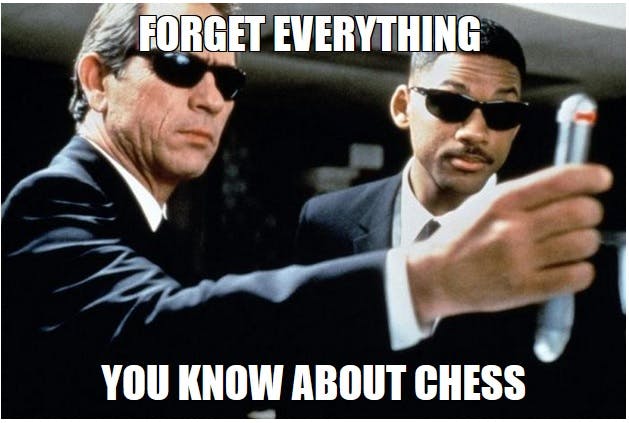Are you sure you want to delete your account?
(This will permanently delete all of your data - purchases, game scores, ratings, etc)
Change your username
Your current username is: guest
Change your account email address
Your current account email is:
Redeem your Fampay code here!
Use your Fampay code to get access to the Play Magnus Plus Membership!

The Power of Unlearning
As GM Jonathan Rowson points out in his brilliant book "Chess for zebras", for adult players unlearning is often more important than learning. Indeed, throughout our lives, we acquire many stereotypes and limitations that might hinder our decision-making process during the game. For instance, let's list some of the shortcomings that are common among novice chess players:
• Making too many moves with the same piece in the opening and forgetting to develop your pieces harmoniously.
• Trying to develop major pieces way too early and exposing them to attacks. For instance, playing a4 and h4 followed up by Ra3 and Rh3.
• Giving up two minor pieces for a rook and the f7-pawn, thinking this is a great way to attack the opponent's king.
• Pushing pawns randomly and never looking back, thus creating terrible weaknesses in one's camp.
• Underestimating the importance of castling.
• Initiating trades for the sake of doing so. Basically, being happy about capturing something and never considering the positional implications of the exchange.
• Grabbing irrelevant pawns and neglecting development.
The list could go on forever. Hopefully, you are smiling and shaking your head now since you realize pretty well why the activities mentioned above are faulty. However, for quite a few chess players, it takes some effort to unlearn these things and replace the bad habits with the new, good ones. Or, even worse, some club players end up making the same mistakes throughout their entire career and failing to improve since they never reflect on their play.
I won't dwell much on this subject, because you can always consult the original book in case you are interested. Instead, I will try to offer you an antidote in the form of tips on minimizing the harmful effects of this plague.
Rule #1: make sure your sources of information are credible and qualified. Simply put, deal with reputable coaches and authors instead of self-proclaimed gurus.
Nowadays, the situation is much more beneficial for an aspiring chess fan because there are plenty of opportunities for studying online. Previously, a common occurrence was that the head of a chess club would often single-handedly shape his students' perception of chess. Since most local coaches were amateurs who had somewhat limited knowledge of the game, this typically led to the development of all sorts of chess biases. Common examples of this type are: exclusively playing offbeat openings, favoring tactics and ignoring strategy or vice versa, promoting the "if you play for checkmate, there is no need to study endgames" approach, etc. If you have been taught to do something the wrong way at an early age, it is rather challenging to get rid of the habit later on. Therefore, some potential chess careers have been cut at the very start by an unfortunate choice of the first coach for the child.
Rule #2: try to play reasonably strong opposition and study masters' games instead of repeatedly beating weaker players and subconsciously absorbing their mistakes. Chess is a game of patterns.
The principle of communicating vessels works here. If you keep facing inferior opponents, you are basically giving them a free lesson and helping them close the gap between you. Semi-pro Grandmasters who make a living by playing open tournaments are financially incentivized to ignore this principle, but they typically get stuck in a rut and fail to progress to the super events. To rise higher, you have to be prepared to invest time, effort, and money in your chess development.
Rule #3: eliminate the shortcomings in your thinking process using the "list of mistakes" technique and the "diagram method". Let's discuss the second concept in more detail since we haven't touched upon it yet in the Play Magnus blogs.
IM Mark Dvoretzky and GM Artur Yusupov introduce this extremely instructive method in the first volume of the "School of future chess champions" series. We encounter a lot of exciting and worth remembering positions when analyzing games or studying chess. The idea is to make a diagram with the position and to add notes to it. This can be especially useful when combined with the "list of mistakes" method, i.e., each notable mistake gets a diagram and a comment on what went wrong and how you should treat such a position in the future.
Such an approach allows a powerful way of memorizing one's findings and of refreshing the ideas once in a while. Of course, there is another valuable bonus: such a technique is indispensable for coaches or authors because the diagrams and notes lay a sound foundation for a future book or exercise kit.
The "hardcore" method involves drawing these diagrams with a pencil in a special notepad. One of my friends pointed out that it's exactly how it should be done because you invest a significant effort into the process and thus understand and memorize the case better. However, I am too lazy and talentless as an artist to follow this advice, so I just press the "copy position" button in ChessBase and then paste the diagram into a Word document. This way, it takes just a few seconds to add an example to the collection. Also, if you back up the data on your computer's hard drive regularly enough, such a means of storage is safer than paper notebooks that are easily lost, crumpled, or used for drawing by kids. Finally, you can always print the diagrams out if you want to have a hard copy handy.
The more high-quality chess information you acquire at the early stages of your chess learning, the fewer bad habits you will form and the easier it will be to get rid of the hurdles blocking your chess progress. One of the best ways of ensuring that what you study will benefit you for years to come is to learn from the World Chess Champion Magnus Carlsen by following a training course devised by him and his expert team. Download Magnus Trainer for free and give it a try if you are not already using the app!

